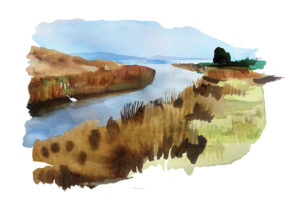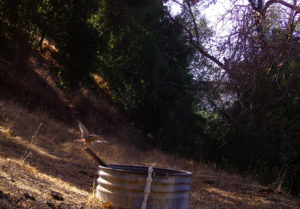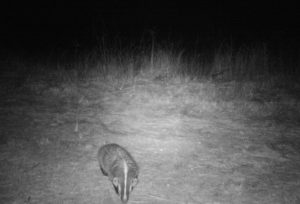
On February 5, it will be the Year of the Pig. But in Bay Area open spaces, you might say that every year is the year of the pig. And these wild animals are not the cheerful, cartoonish “Some Pig” of children’s literature and zodiac calendars.
The reality here is bristly, almost shaggy, and dark. Many wild pigs are a charcoal color, a black tinged with brown and gray, though some of them are red or patterned with stripes and spots. Like many other feral pig populations, California’s started when the Spanish imported domestic pigs during the 1700s. Allowed to roam free to forage, they eventually became feral. In the 1920s, a Monterey County landowner and avid hunter, George Gordon Moore, introduced wild boar to his ranch. Again allowed to go wherever they want, the population grew and spread, and eventually bred with domestic pigs to create the hybrid that plagues Bay Area homes today.
Why plagues? Pigs feed by uprooting the earth in search of food. They can easily destroy a front lawn in a single night. They’ve disrupted San Jose neighborhoods, near where this photo was captured, in their quest to find food. If they’re not turning over every clump of dirt in your lawn, they’re eating your beloved plants instead. They compete with native wildlife for the same food. Upturning the earth also disturbs plants that aren’t otherwise adapted, exposing roots and leaving them to die. Pigs can destroy creeks when creating their wallows.

It’s not a problem that’s easily solved. With large litters, pigs spread fairly rapidly. The California Department of Fish and Wildlife classifies them as a game animal that can be hunted any time throughout the year, provided the hunter has a license. CDFW suggests seeking out local hunters if you have pigs bothering your land — and even offer their own hunters, free of charge. It’s not a solution likely to make animal lovers happy, but it’s currently the only one the CDFW can offer.
The herd captured in this camera trap looks innocent, but their destructive nature can’t be overstated. Pigs will continue to be a problem for California wildlife for some time to come. One day, maybe, we’ll find a better solution, but for now we just have to learn to deal with our neighbors, unwanted as they are.




